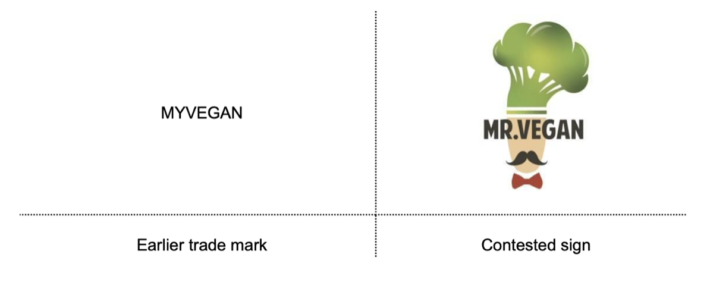 THE CASE
THE CASE
The Hut.com Limited – UK legal entity filed an opposition against Калоян Георгиев, represented by IP Consulting Ltd., 6-8, Mitropolit Kiril Vidinski Str., Entr. 8, Floor 2, Office 2, 1164 Sofia, Bulgaria (professional representative).
On 05/05/2021, the opponent filed an opposition against all the goods of European Union trade mark application No 18 383 712 (figurative mark). The opposition is based on international trade mark registration designating Spain and Italy No 1 492 554, ‘MYVEGAN’ (word mark). The opponent invoked Article 8(1)(b) EUTMR.
The goods and services
The goods and services on which the opposition is based are the following:
- International trade mark registration No 1 492 554: Classes: 5, 29, 30, 35.
- The contested goods are the following: Classes: 29, 30, 31, 32.
Some of the contested goods are identical or similar to goods and services on which the opposition is based. For instance, the opponent’s vitamin, protein and mineral enriched foods and foodstuffs, namely, meat in Class 29 of international trade mark registration designating Italy No 1 492 554 overlaps with the contested meat and meat products in Class 29, being therefore identical.
Relevant public — degree of attention
The average consumer of the category of products concerned is deemed to be reasonably well informed and reasonably observant and circumspect. It should also be borne in mind that the average consumer’s degree of attention is likely to vary according to the category of goods or services in question.
In the present case, the goods and services assumed to be identical are directed at the public at large and as well as business customers with specific professional knowledge or expertise. The degree of attention may vary from average to relatively high depending on their nature.
The signs

Visually, the signs coincide in the letters ‘M* VEGAN’; however, they differ in the signs’ respective second letters ‘Y’ in the earlier mark and ‘R.’ in the contested application. The signs also differ in the contested sign’s graphical elements and stylisations.
Aurally, the signs coincide in the sound of the letters ‘M* VEGAN’; however, they differ in the sound of the signs’ respective second letters ‘Y’ in the earlier mark and ‘R’ in the contested application. Furthermore, the contested sign’s component ‘MR.’ will be pronounced as /mistr/.
Conceptually, reference is made to the previous assertions concerning the semantic content conveyed by the marks and the degree of distinctiveness of their elements. As a whole, the earlier mark’s verbal element ‘MYVEGAN’ will be perceived as conveying the meaning of ‘something that is vegan and is mine’ whereas the contested application’s component ‘MR. VEGAN’ evokes the concept of ‘a men that is vegan’. This latter concept is somehow evoked also by the contested sign’s figurative element. In any event, the signs coincide only in the concept of vegan that retains, at most, a very low distinctive character. Conversely, they differ in all the remaining outlined semantic aspects. Therefore, they are conceptually similar to a low degree.
CONCLUSION
Opposition No B 3 145 989 is rejected in its entirety.

